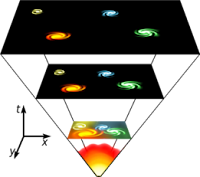The matter making the solar system, the Earth, all living beings and ourselves, is made up almost entirely of atoms which, in turn, are based on three elementary particles: protons, neutrons and electrons. For each of these particles, as well as for many others, not usually part of atoms, there is an antiparticle. Therefore, there could be antimatter antiatoms, made of antiprotons, antineutrons, and antielectrons (positrons).
An interesting property of matter and antimatter is that they cannot be together. As soon as they come into contact, they completely disintegrate, transforming into energy. Everything suggests that our galaxy (the Milky Way) is made up almost exclusively of matter. There is also some antimatter, in the form of antiparticle clouds, outside the galaxy, close to it and attracted by its gravity, but in such a small quantity, compared to the mass of the galaxy, that for practical purposes it can be ignored. It has also been said that there could be some (but very few) anti-stars.
Formerly it was
believed that, just as there are galaxies of matter, there should be galaxies of antimatter in
other regions of the universe. Human
beings want to find symmetries everywhere. Therefore, if there is a lot of
matter in the universe, there should also be a lot of antimatter: exactly the
same amount. But then, when two galaxies collide with each other, if one of
them were made of matter and the other of antimatter, they should disintegrate,
and the consequent energy output would be so great that we could detect it. This
has never been seen, even though there are many cases of colliding galaxies, some
quite close to us, for the Andromeda galaxy is hurtling towards us and will
collide with the Milky Way in a few billion years.
One possibility
that has been proposed is that there are distinct
regions in the universe. Although there
seems to be nothing but matter in the entire visible universe, beyond the limit
of our vision there could be regions dominated by antimatter, and so, on huge
scales, there would be no asymmetry. This option is purely speculative, because
it cannot be scientifically proven.
Today it is thought that it is very likely that the laws of physics are asymmetric, and that the amount of matter that was produced very close to the Big Bang was slightly greater than the amount of antimatter. Not very: for every billion atoms of antimatter there would have been just one more atom of matter (a billion plus one). When the billion atoms of antimatter disintegrated with the billion atoms of matter, one atom of matter would have been left over. From this would come all the atoms of matter making galaxies. There would therefore be no antimatter galaxies.
Where does the asymmetry come from? In fact, we don’t know, although various theories try to explain it.
- Violation of CP symmetry: In some reactions between elementary
particles, we don’t get the same result if the sign of the electric charge
of the particles is changed (symmetry C, Charge) together with the right side and the left side
(symmetry P, Parity). This asymmetry has been verified
experimentally, which suggested to Isaac Asimov the title of one of his
articles, and of the collection to which it belongs: The left hand of the
electron. The
problem is, for this asymmetry to explain the predominance of matter, more
conditions should be met, such as that the
principle of conservation of baryon number is not always obeyed. This means that the proton should decay over
time, which has not been verified.
- Existence of an anti-universe: According to this theory, the Big Bang would have given rise to the simultaneous
appearance of two universes, one dominated by matter and the other by
antimatter. Both together would be symmetric. One possible consequence is
that there should be a large number of new particles, the superheavy sterile neutrinos, which could be the basis of dark matter. The
bad news is that, until now, the existence of these neutrinos has not been
demonstrated.
- Antimatter could be hidden in
dark matter: According
to another theory, a hypothetical particle called Φ,
which would have existed shortly after the Big
Bang, before protons and
neutrons appeared, could have decayed into a normal matter particle and a dark
antimatter particle. Since we don't know what dark matter is, nothing else
can be said about this theory.
There are other
theories that try to solve the problem, but none of them go beyond the level of
unproven hypothesis. Consequently, we must consider that the problem of the
existence of matter in the universe has not been solved, for the time being.
Along with dark matter and dark energy, this is one of the hardest remaining mysteries
in contemporary physics.
Thematic Thread about Standard Cosmology: Previous Next



No comments:
Post a Comment